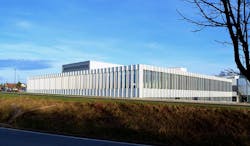TRUMPF inaugurates new solid-state laser facility
Ditzingen, Germany--Industrial laser manufacturer TRUMPF has expanded its primary solid-state laser development facility by erecting a new building at the town of Schramberg-Sulgen with 6200 square meters of floor space. With about 250 guests in attendance, the official opening took place on March 6, 2013. The two floors in the Development Center house both office space and laboratories dedicated to the development of solid-state lasers.
Investment volume for this new project came to 13.5 million euros ($17.6 million dollars) while construction took 17 months. This investment is a clear expression of TRUMPF's commitment to the site and to its innovation and growth strategy. At the opening ceremonies Peter Leibinger, vice-chairman of the TRUMPF Group Management Board, said, "Schramberg is not only the cradle of the German laser industry. Today it is one of the world's leaders in laser technology development and production." Professor Reinhart Poprawe, director of the Fraunhofer Institute for Laser Technology in Aachen, emphasized another point in his dedication speech: "The laser is playing a decisive role in the design of tomorrow's production technologies. And to that end we need--in addition to a superior research setting at universities and other institutions--highly innovative companies like TRUMPF."
Numerous industrial manufacturing processes have been made possible by such lasers as solid-state lasers built by TRUMPF Laser GmbH + Co. KG. These lasers, originating in the Black Forest, will be found both in small-scale devices for the semiconductor industry and as high-performance lasers in vehicle manufacture. TRUMPF also uses the solid-state lasers in its own machine tools.
All the development sections at Schramberg will, for the first time, be consolidated under a single roof. In the past, these units were located in a number of different buildings around the site. TRUMPF will be using the floor space freed up there to expand its production capacities for solid-state lasers. Barkow Leibinger architects in Berlin planned the new two-story structure. This square building, measuring 52 x 52 meters, is distinguished by the way it utilizes the site’s topography. The lower level is almost completely embedded in a slope. To be found on that floor are laser testing laboratories, a climate control chamber, and the building's utility services--functions that need little or no daylight. On the upper floor are office and conference rooms. The façade for this story is made entirely of glass. Slender, laser-cut aluminum fins run the entire height of the building, lending structure to the façade. An atrium on the office level provides additional daylight.
The completion of the Development Center marks a milestone in expansion activities at the TRUMPF site in Schramberg. Now in the planning stage is an addition to the shipping unit. The newly completed Development Center could be expanded at any time by topping it with a third story. "The application options for laser technology are by no mean[s] exhausted," said Peter Leibinger in his speech. "And Schramberg will continue to play a superior part in ensuring that Germany continues to hold a top position, all around the world, in the field of industrial lasers."
SOURCE: TRUMPF; http://www.trumpf.com/nc/en/press/press-releases/press-release/rec-uid/248113.html

Gail Overton | Senior Editor (2004-2020)
Gail has more than 30 years of engineering, marketing, product management, and editorial experience in the photonics and optical communications industry. Before joining the staff at Laser Focus World in 2004, she held many product management and product marketing roles in the fiber-optics industry, most notably at Hughes (El Segundo, CA), GTE Labs (Waltham, MA), Corning (Corning, NY), Photon Kinetics (Beaverton, OR), and Newport Corporation (Irvine, CA). During her marketing career, Gail published articles in WDM Solutions and Sensors magazine and traveled internationally to conduct product and sales training. Gail received her BS degree in physics, with an emphasis in optics, from San Diego State University in San Diego, CA in May 1986.
